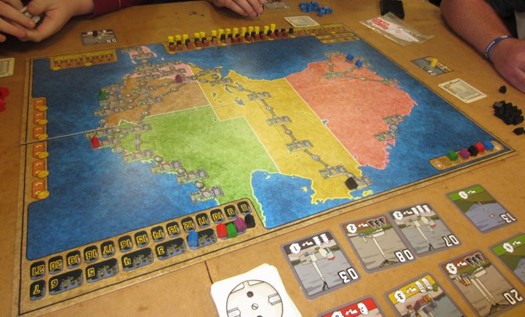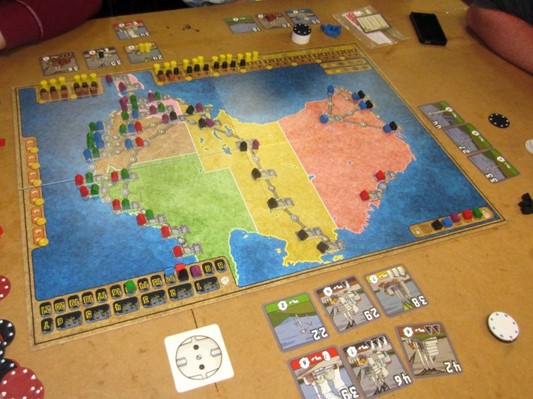Last night saw some enjoyable board-gaming time. I played a game of X-Wing with Sarah, her first in some time, as she attempted to grapple with visualising star fighter (and bigger ships) movement. We then had a four-player game of Nations, which I won handily. My first win of Nations. Hooray! And finally we played a five-player game of Power Grid with the new Australia board.
And we got part of the set-up badly wrong. Oops.

Playing this game with me were Sarah, John, Jesse and Glen. Only Sarah and I had played Power Grid before, and this was like no game of Power Grid we’d played, mainly due to there being no Uranium power plants – they were mines instead. The order of the plants saw a lot of better, bigger plants come out early, and in the second turn I bought the #28 power plant (1 Uranium -> 4 towns) for almost $40, the auction being entirely between me and Jesse as everyone else had already bought plants. I had begun the game with the #4 power plant (2 coal->1 town), so I was quite worried about my lack of capacity. The Uranium Mine I was buying would not power cities… but it would provide me with money. I thought I bought it for too much. Little did I know!
Uranium Mines sell their Uranium each turn to a foreign market, which has its own resource track on the side of the board. You multiply the number of towns you could power (the plant’s production) by the highest unused value on the Uranium Demand track, and get that much money. You then place one Uranium per mine (plant) on the Demand track, lowering the price. If there are several mines in play, it can lower pretty quickly, but for much of the game, only my mine was in play, and the one uranium that hit the track was being removed during the Bureaucracy step, so the mine was giving me $28 per turn with no need to connect cities.
This, in fact, was wrong. Not how the Uranium Mine worked, but we began with the Uranium Demand track empty, thus I was able to sell for the highest price. In fact, it should have been filled! Thus, my initial sales should have been at $3*4 or $12. The next turn, with no new Uranium Mines coming out and with the demand increasing, should have been at $4*4 for $16.
We thought the Uranium Mines were unbalanced as we played (especially as I had the only one for quite some time). They’re still good – they’re just shouldn’t be *that* good!

By the end of the game, I was way in front. This wasn’t entirely due to my extra money, although that certainly helped. Sarah spent the first few turns of the game having the most cities, so I was able to get the best of the power plant market, aided by the new players occasionally bidding when they shouldn’t. Sarah and I did guide them on the times when they absolutely should pass, or when a plant was a really bad choice to buy, but they would go their own ways.
The power plants also saw a lot of good plants come up early, mainly from turns 3-6, so for those of us who knew which plants to buy, we were well placed for the endgame. The biggest factor limiting our expansion was the map: it is expensive to connect around. Sarah’s one chance to be competitive was stopped by my purchases of a couple of city connections that blocked her expansion, but fighting against the misplayed uranium mines was hard at the best of times.
When the game ended, I still had over $50 with 15 connected (and powered) cities… the next best city count was 12!
So, the moral of this story is: don’t misread the set-up instructions!
I dare say we’ll get another chance to play the game with the Australia map quite soon, so I hope to soon bring you a proper session report of how the new map plays!
